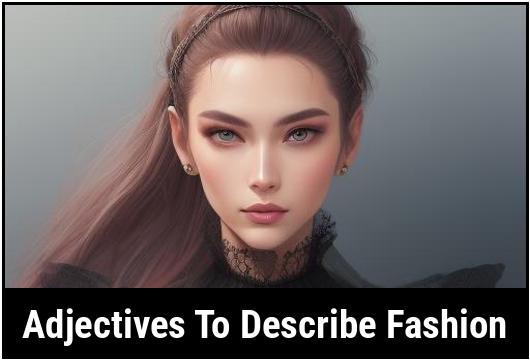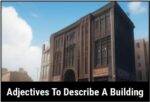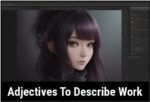- You are here:
- Home »
- adjectives
- » 31 Adjectives To Describe Fashion

31 Adjectives To Describe Fashion
Fashion is a reflection of personal style, creativity, and expression. It encompasses a wide range of trends, designs, and aesthetics, making it a highly diverse and dynamic field. When discussing fashion, the use of adjectives plays a crucial role in accurately conveying the nuances of various styles, garments, and overall looks. Adjectives aid in articulating the mood, quality, and characteristics of clothing, making it easier to communicate and comprehend the intricacies of fashion. This comprehensive guide explores the significance of using adjectives to describe fashion, the process of selecting the right adjectives, and the various types of adjectives commonly employed in fashion descriptions.
Key Takeaways
- Adjectives provide detailed and vivid descriptions of fashion, enabling individuals to express their preferences and opinions regarding different styles and clothing items.
- The judicious use of adjectives enhances communication and comprehension within the fashion industry, fostering a deeper appreciation for diverse aesthetic sensibilities.
- Selecting the appropriate adjectives allows for precise and evocative expressions, enabling one to effectively convey the intricacies of fashion trends, designs, and personal style choices.
Adjectives To Describe Fashion
1. Chic
Chic is an adjective often used to describe a sense of elegance and sophistication in fashion. It refers to a style that is effortlessly stylish and polished. A chic outfit may combine timeless pieces with modern trends, creating a harmonious and refined look.
2. Daring
Fashion can also be described as daring when it pushes boundaries and challenges the norms. Daring fashionistas are not afraid to experiment with bold colors, unconventional silhouettes, and statement accessories, creating eye-catching and memorable looks.
3. Classic
Classic fashion never goes out of style. This adjective refers to timeless pieces that have stood the test of time, maintaining their appeal throughout the years. A classic wardrobe often consists of tailored blazers, simple white shirts, tailored trousers, and little black dresses.
4. Eclectic
The word eclectic perfectly describes a fashion style that borrows from various sources and influences. Eclectic fashionistas have a knack for seamlessly blending different eras, cultures, and styles, creating unique and visually-striking outfits.
5. Effortless
Effortless fashion is all about looking put-together without appearing like too much effort was exerted. This adjective describes a style that exudes an air of ease and nonchalance. Think of flowy dresses, casual ensembles, and minimalistic accessories.
6. Quirky
Quirky fashion celebrates individuality and embraces unconventional aesthetics. This adjective describes outfits that are offbeat, playful, and unconventional. Think mismatched prints, funky accessories, and unexpected combinations.
7. Sophisticated
Sophisticated fashion conveys refinement and poise. It refers to well-tailored garments, luxurious fabrics, and subtle details. Sophisticated outfits exude an air of elegance and grace, often seen in formal and upscale events.
8. Trendy
Trendy fashion revolves around current styles and popular fashion movements. This adjective describes outfits that incorporate the latest trends, whether it’s the "it" color of the season or the must-have accessory. Trendy fashionistas are always in the know and strive to stay ahead of the curve.
9. Bohemian
Bohemian fashion is often associated with a free-spirited and carefree lifestyle. This adjective describes outfits that feature flowing fabrics, earthy tones, and an array of textures. Bohemian fashion celebrates nature, individuality, and a sense of adventure.
10. Edgy
Edgy fashion embraces a rebellious and bold aesthetic. This adjective describes outfits featuring unconventional cuts, avant-garde designs, and a dark color palette. Edgy fashionistas often gravitate towards leather jackets, ripped jeans, and studded accessories.
11. Whimsical
Whimsical fashion captures a playful and imaginative essence. This adjective describes outfits that incorporate whimsical prints, fantastical themes, and quirky elements. Outfits with polka dots, unicorns, or novelty prints embody the whimsical spirit.
12. Elegant
Elegant fashion exudes grace, refinement, and a touch of glamour. This adjective describes outfits that are sophisticated, refined, and tasteful. From flowing evening gowns to tailored pantsuits, elegant fashion showcases utmost style and finesse.
13. Retro
Retro fashion draws inspiration from past eras. This adjective describes outfits that pay homage to nostalgic styles, such as 1950s pin-up dresses, 1970s flared pants, or 1980s power suits. Retro fashion allows individuals to transport themselves to bygone decades.
14. Vibrant
Vibrant fashion embraces bold and energetic colors. This adjective describes outfits that are eye-catching, lively, and joyful. Vibrant fashionistas utilize bright hues, such as electric blue, radiant yellow, or fiery red, to make a memorable fashion statement.
15. Minimalistic
Minimalistic fashion celebrates simplicity, clean lines, and understated elegance. This adjective describes outfits that rely on neutral colors, sleek silhouettes, and minimal accessories. Minimalistic fashion communicates a sense of modernity and sophistication.
16. Romantic
Romantic fashion embodies dreamy, feminine aesthetics. This adjective describes outfits with delicate details, soft colors, and floaty fabrics. Flowing maxi dresses, lace, and ruffles often feature in romantic fashion, creating a fairytale-like ambiance.
17. Athletic
Athletic fashion merges style and functionality. This adjective describes outfits that prioritize comfort and movement, often associated with activewear and sport-inspired clothing. Athletic fashion celebrates an active and healthy lifestyle.
18. Unique
Unique fashion embraces individuality and stands out from the crowd. This adjective describes outfits that are one-of-a-kind, with unexpected combinations, unusual textures, and distinctive accessories. Unique fashionistas are not afraid to experiment and express their personal style.
19. Glamorous
Glamorous fashion evokes a sense of allure and luxury. This adjective describes outfits that shimmer with sequins, feature fur or metallic accents, and exude extravagance. Glamorous fashion is often spotted at red carpet events and formal occasions.
20. Playful
Playful fashion captures a sense of positivity, youthfulness, and fun. This adjective describes outfits that incorporate whimsical prints, vibrant colors, and unconventional cuts. Playful fashion encourages self-expression and creativity.
21. Bold
Bold fashion embraces statements and draws attention with its audacity. This adjective describes outfits that feature daring prints, vibrant colors, and eye-catching accessories. Bold fashionistas are not afraid to make a statement and leave a lasting impression.
22. Polished
Polished fashion exudes an air of professionalism and sophistication. This adjective describes outfits that are meticulously put together, often featuring tailored pieces, crisp lines, and refined accessories. Polished fashion is ideal for formal settings and work environments.
23. Artistic
Artistic fashion showcases an appreciation for creativity, artistic expression, and unconventional designs. This adjective describes outfits that resemble wearable art, often incorporating avant-garde silhouettes, unique prints, and sculptural accessories.
24. Exotic
Exotic fashion embraces inspirations from different cultures and places. This adjective describes outfits that showcase vibrant prints, intricate embroidery, and unique textures. Exotic fashion allows individuals to explore the beauty of cultural diversity through their style.
25. Timeless
Timeless fashion refers to garments, styles, and accessories that transcend trends and remain fashionable for years to come. This adjective describes outfits that have a enduring appeal and can be worn with confidence at any time or occasion.
26. Refined
Refined fashion conveys elegance, sophistication, and a keen attention to detail. This adjective describes outfits that exude a polished and cultivated aura. Refined fashion strikes the perfect balance between simplicity and understated luxury.
27. Quaint
Quaint fashion celebrates nostalgia and the charm of yesteryears. This adjective describes outfits that incorporate vintage elements, featuring retro-inspired prints, delicate lace, and granny-chic accessories. Quaint fashion transports individuals to a bygone era.
28. Sustainable
Sustainable fashion prioritizes eco-friendliness and ethical production practices. This adjective describes outfits created from organic, recycled, or upcycled materials, promoting a more responsible and conscientious approach to clothing.
29. Versatile
Versatile fashion describes outfits that can be easily transformed and worn in various ways. This adjective refers to garments that can adapt to different occasions, with interchangeable pieces, and the ability to be dressed up or down.
30. Effervescent
Effervescent fashion captures a lively, bubbly, and vivacious spirit. This adjective describes outfits that brim with energy, bright colors, and playful designs. Effervescent fashion radiates positivity and joy.
31. Fashion-forward
Fashion-forward describes individuals who are ahead of the curve when it comes to trends and style. This adjective refers to cutting-edge outfits that incorporate the latest fashion movements, setting trends rather than following them.
Why Use Adjectives To Describe Fashion
Adjectives serve as indispensable linguistic tools for conveying the myriad facets of fashion. The utilization of adjectives in fashion descriptions allows individuals to encapsulate the essence, mood, and attributes of various garments, styles, and overall fashion sensibilities. With the rapid evolution and diversification of fashion, the need to employ adjectives to depict its multifaceted nature becomes increasingly essential. By employing adjectives, one can manifest a rich and vivid description of fashion, enabling others to effectively visualize and understand the characteristics and qualities of different fashion styles and trends.
Moreover, adjectives play a crucial role in articulating personal preferences and discernment in fashion. They enable individuals to convey their subjective evaluations of clothing items, styles, and aesthetics, fostering a nuanced and articulate discourse on fashion. Whether it involves discussing the opulence of couture gowns, the minimalism of streetwear, or the exuberance of retro fashion, adjectives provide a means of expressing the distinct attributes and appeal of each style.
How To Choose The Right Adjective To Describe Fashion
Selecting the appropriate adjectives to describe fashion necessitates a keen understanding of the specific attributes one seeks to convey. When choosing adjectives for fashion descriptions, several factors should be considered:
-
Context: Assess the context in which the fashion description is presented. Whether it pertains to a formal critique, casual conversation, or marketing copy, the context dictates the tone and style of adjectives employed.
-
Aesthetic Attributes: Identify the aesthetic qualities and characteristics of the fashion item or style. Consider aspects such as color, texture, silhouette, and overall visual impact to determine the most fitting adjectives.
-
Emotional Impact: Reflect on the emotional resonance and mood evoked by the fashion item or style. Adjectives can encapsulate emotions such as elegance, edginess, whimsy, or sophistication, conveying the emotional essence of the fashion.
-
Target Audience: Consider the preferences and sensibilities of the intended audience. Adjectives should resonate with the audience’s tastes and perceptions of fashion, ensuring that the description effectively communicates the desired message.
By conscientiously assessing these factors, one can discern and employ adjectives that encapsulate the essence and nuances of fashion, offering a vivid and accurate portrayal of diverse stylistic expressions.
Types Of Adjectives For Describing Fashion
Adjectives employed in fashion descriptions encompass a broad spectrum of qualities, styles, and characteristics, each serving to enrich and enliven the depiction of clothing and styles. The following are various types of adjectives extensively used in the context of fashion:
1. Descriptive Adjectives
Descriptive adjectives vividly depict the physical attributes and visual qualities of fashion items. These adjectives convey details regarding color, pattern, texture, shape, and other tangible characteristics, enabling individuals to form a clear mental image of the clothing or style being described.
Example: "The ethereal dress featured intricate lace detailing and cascading layers, imparting an enchanting allure."
2. Mood Adjectives
Mood adjectives communicate the emotional ambiance and evocative tone elicited by fashion styles. These adjectives capture the atmosphere and sentiment associated with a particular garment or overall fashion aesthetic.
Example: "The sleek, monochromatic ensemble exuded an air of understated sophistication, accentuating a refined and modern allure."
3. Qualitative Adjectives
Qualitative adjectives denote the inherent qualities and characteristics of fashion items, elucidating their intrinsic merits, craftsmanship, and design elements. These adjectives highlight the craftsmanship, materials, construction, and overall quality of the clothing or accessory described.
Example: "The luxurious coat showcased impeccable tailoring and sumptuous, opulent fabric, epitomizing timeless elegance and unparalleled craftsmanship."
4. Style Adjectives
Style adjectives encompass a diverse range of descriptors that elucidate the specific fashion genre, aesthetic approach, or design sensibility embodied by a particular garment or fashion trend. These adjectives encapsulate the stylistic ethos, genre, and aesthetic vernacular of the clothing or style in question.
Example: "The avant-garde ensemble seamlessly fused urban streetwear elements with avant-garde tailoring, encapsulating a boundary-pushing sartorial vision."
5. Comparative Adjectives
Comparative adjectives facilitate the juxtaposition and comparison of fashion items, delineating their relative merits, attributes, or distinctive features. These adjectives are employed to contrast, differentiate, or highlight the unique qualities of different fashion styles or garments.
Example: "The contemporary reinterpretation of the classic trench coat showcased a bolder silhouette and modernized details, setting it apart from traditional iterations."
6. Trend Adjectives
Trend adjectives denote the contemporary relevance, zeitgeist, and fashionable appeal of certain styles, reflecting their currency and resonance within the fashion landscape. These adjectives capture the zeitgeist, modernity, and relevance of fashion trends and styles.
Example: "The retro-inspired ensemble exuded nostalgic charm and a contemporary flair, seamlessly blending vintage references with a modern, urban sensibility."
The art of describing fashion through adjectives is a sophisticated and essential practice that amplifies the communication and appreciation of diverse sartorial expressions. By employing adjectives that aptly capture the visual, emotional, and qualitative nuances of fashion, individuals can convey the essence and allure of clothing styles, trends, and aesthetic sensibilities with precision and eloquence. The judicious selection of adjectives is pivotal in enriching fashion discourse, fostering nuanced discussions, and enhancing the comprehension and articulation of the multifaceted realm of fashion. As fashion continues to evolve and diversify, the discerning use of adjectives remains an invaluable tool for articulating the ever-changing tapestry of styles, trends, and designs that define contemporary sartorial landscapes.
Examples Of Adjectives For Different Types Of Fashion
In the world of fashion, adjectives play a crucial role in describing the endless array of styles, outfits, and trends. Whether you’re discussing haute couture or casual everyday wear, utilizing descriptive and precise adjectives can elevate your fashion vocabulary.
-
Casual: When describing everyday, relaxed attire, adjectives such as comfortable, relaxed, effortless, and simple come to mind. For instance, you could describe a casual outfit as "comfy jeans and a cozy sweater" or a "relaxed t-shirt and shorts ensemble."
-
Formal: Formal fashion is typically associated with elegant and sophisticated attire. Adjectives like refined, polished, chic, and sophisticated capture the essence of this style. For example, you might describe a formal dress as "a refined gown with exquisite detailing" or a suit as "a polished and tailored ensemble."
-
Bohemian: The bohemian style embraces earthy and free-spirited elements. Adjectives such as carefree, eclectic, boho, and artistic effectively describe this fashion genre. For instance, you might describe a bohemian outfit as "a flowing maxi dress with colorful patterns" or "an eclectic mix of vintage and handmade pieces."
-
Retro/Vintage: Retro or vintage fashion refers to styles from previous eras. Adjectives like nostalgic, classic, timeless, and retro perfectly capture the essence of this fashion trend. For example, you could describe a retro dress as "a timeless silhouette with a vintage print" or "a classic, 1950s-inspired outfit."
-
Streetwear: Streetwear is a fashion subculture that draws inspiration from urban environments. Adjectives such as edgy, urban, trendy, and bold effectively describe this style. For instance, you might describe a streetwear outfit as "an edgy, graphic t-shirt paired with ripped jeans" or "a trendy tracksuit with bold logos."
-
Glamorous: Glamorous fashion exudes luxury, opulence, and elegance. Adjectives like glamorous, extravagant, luxurious, and lavish perfectly describe this style. For example, you could describe a glamorous gown as "an extravagant dress with shimmering sequins" or "a luxurious fur coat paired with elegant accessories."
-
Minimalist: Minimalistic fashion focuses on simplicity, clean lines, and neutral colors. Adjectives such as minimal, clean, sleek, and understated adequately describe this style. For instance, you might describe a minimalist outfit as "a clean-cut blazer with tailored trousers" or "an understated dress with minimal accessories."
-
Athletic: Athletic fashion refers to clothing designed for sports or active lifestyles. Adjectives like sporty, athletic, functional, and performance-oriented capture the essence of this style. For example, you could describe athletic wear as "sporty leggings with moisture-wicking fabric" or "functional sneakers designed for high-performance activities."
-
Romantic: Romantic fashion embraces delicate fabrics, floral patterns, and feminine silhouettes. Adjectives like romantic, delicate, whimsical, and feminine effectively describe this style. For instance, you might describe a romantic outfit as "a delicate lace dress adorned with floral accents" or "a whimsical skirt paired with a feminine blouse."
-
Avant-Garde: Avant-garde fashion pushes the boundaries of traditional style and experiments with unconventional designs. Adjectives like avant-garde, experimental, innovative, and unconventional capture the essence of this genre. For example, you could describe an avant-garde outfit as "an innovative and unconventional ensemble with asymmetrical cuts and bold color combinations."
Common Mistakes In Using Adjectives To Describe Fashion
While adjectives are excellent tools for describing fashion, there are common mistakes people make when utilizing them. Here are a few mistakes to avoid:
- Overusing generic adjectives: Using generic adjectives like nice, pretty, or cool can make your descriptions lack impact and specificity. It’s essential to select more descriptive and precise adjectives that paint a vivid picture of the fashion item or style.
Incorrect: "Her dress is nice."
Correct: "Her dress is elegant and sophisticated."
- Using contradictory adjectives: Be cautious when using adjectives that contradict each other, as they can create confusion or undermine your description.
Incorrect: "His outfit is both vibrant and dull."
Correct: "His outfit is vibrant and eye-catching."
- Failing to consider the context: Context plays a significant role in choosing appropriate adjectives. Remember to consider the occasion, style, and intended message when describing fashion.
Incorrect: "She wore a flashy dress to the funeral."
Correct: "She wore a somber and respectful dress to the funeral."
- Neglecting to use sensory adjectives: Sensory adjectives can enhance your descriptions by appealing to the reader’s senses. Incorporate words that evoke visuals, tactile sensations, or emotions to create a more immersive description.
Incorrect: "Her outfit is nice."
Correct: "Her outfit is visually stunning and evokes a sense of sophistication."
- Ignoring cultural connotations: Fashion and its associated adjectives can have cultural connotations. Be aware of these nuances and avoid using adjectives that may perpetuate stereotypes or offend certain cultural groups.
Incorrect: "She wore a tribal-inspired outfit."
Correct: "She wore an outfit inspired by traditional indigenous craftsmanship."
Using Adjectives Effectively
To effectively utilize adjectives when describing fashion, consider the following tips:
-
Enhance specificity: Instead of relying on generic adjectives, strive for more specific and vivid descriptors. Instead of saying a dress is "nice," opt for adjectives like exquisite, alluring, or stunning.
-
Accurately describe colors and patterns: When describing fashion, appropriate adjectives can effectively portray the colors and patterns of garments. Instead of simply saying a dress is "red," you could describe it as "a vibrant and fiery red." Similarly, for patterns, you could say a blouse has "intricate floral embroidery" instead of merely stating it has "flowers."
-
Consider texture and fabric: Incorporate adjectives that convey the texture and fabric of the clothing. For example, you could describe a silk dress as "luxuriously smooth" or a cozy sweater as "soft and warm."
-
Match adjectives to the style and occasion: Ensure the adjectives you choose align with the specific style or occasion you are describing. Using adjectives like edgy and bold for a formal event might not accurately reflect the appropriate tone. Consider the purpose of the garment and choose adjectives accordingly.
-
Use sensory adjectives: Engage the reader’s senses by incorporating adjectives that evoke visual, tactile, and emotional experiences. This makes your descriptions more immersive and captivating. For example, you could describe a dress as "flowing like a gentle breeze" or a fabric as "delicately woven."
-
Experiment with figurative language: Explore the use of figurative language such as similes, metaphors, and personification to add depth and creativity to your descriptions. For example, instead of saying a dress is "beautiful," you could say it "radiates elegance like a blooming flower."
-
Adapt to your audience: Consider who you are describing fashion to and adjust your vocabulary accordingly. If you are sharing your fashion knowledge with experts in the field, you can incorporate more technical terms. However, if you are describing fashion to a general audience, use language that is accessible and relatable.
Exercises And Practice
To improve your ability to describe fashion using adjectives, here are some exercises and practice opportunities:
-
Vocabulary Expansion: Make a list of adjectives commonly used to describe fashion. Include definitions and synonyms for each adjective to expand your fashion vocabulary. Practice incorporating these adjectives into sentences to become more familiar with them.
-
Describe Fashion Imagery: Look at fashion magazines or browse fashion websites and choose images that catch your attention. Describe the outfits and styles using adjectives. Aim to be as detailed and vivid as possible in your descriptions.
-
Fashion Show Narration: Imagine you are narrating a fashion show to an audience. Write a script describing each outfit in detail, utilizing a variety of adjectives. Focus on capturing the essence and mood of each style.
-
Peer Feedback: Share your fashion descriptions with a friend or colleague and ask for their feedback. Discuss ways to enhance your descriptions and make them more impactful. Aim for clarity and precision in your choice of adjectives.
-
Revisit Fashion Reviews: Read fashion reviews or critiques by professionals. Analyze how they effectively use adjectives to describe different styles, garments, or fashion shows. Take note of any new adjectives you come across and try incorporating them into your own descriptions.
Conclusion
Describing fashion using adjectives is an art form that adds nuance, creativity, and depth to your fashion vocabulary. By incorporating specific, sensory, and evocative adjectives, you can effectively capture the essence of different styles, garments, and fashion trends. Avoid common mistakes, such as overusing generic adjectives or using contradictory language, and remember to consider the context and cultural connotations of your descriptions. Through exercises and practice, you can expand your fashion vocabulary and refine your ability to describe fashion with precision and flair. So, go ahead and explore the limitless possibilities of adjectives in the world of fashion!
FAQS On Adjectives To Describe Fashion
What Are Some Trendy Adjectives To Describe Fashion?
Some trendy adjectives to describe fashion include "modern," "chic," "edgy," "sleek," and "avant-garde."
How Can I Describe Fashion As Elegant And Sophisticated?
You can use adjectives such as "refined," "classy," "polished," "graceful," and "timeless" to describe fashion as elegant and sophisticated.
What Are Some Casual Adjectives To Describe Fashion?
Some casual adjectives to describe fashion are "relaxed," "effortless," "laid-back," "comfortable," and "casual-cool."
How Can I Use Adjectives To Describe Fashion As Playful And Fun?
You can use adjectives like "whimsical," "playful," "quirky," "vibrant," and "colorful" to describe fashion as playful and fun.
Can You Suggest Some Adjectives To Describe Fashion As Bold And Daring?
Yes, some adjectives you can use to describe fashion as bold and daring are "daring," "avant-garde," "unexpected," "fierce," and "standout."








